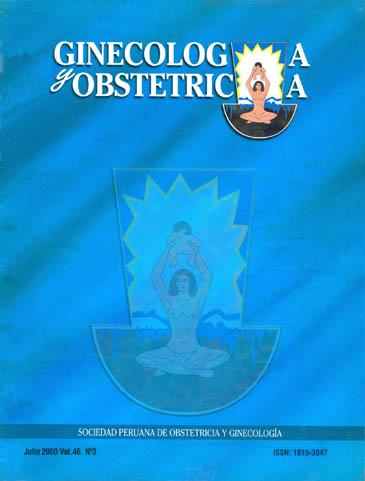Mortalidad perinatal: factores de riesgo asociados. Hospital Regional de Huacho
DOI:
https://doi.org/10.31403/rpgo.v46i1420Resumen
OBJETIVOS: Conocer las tasas y los factores de riesgo asociados a la mortalidad perinatal. DISEÑO: Estudio descriptivo, analítico, de corte transversal, de tipo casos y controles. MATERIAL Y MÉTODOS: Se revisó 4413 historias clínicas del banco de datos del Sistema Informático Perinatal de los partos ocurridos entre enero de 1998 y diciembre de 1999 en la Institución. RESULTADOS: Se obtuvo 4322 productos de peso mayor de 999 g ó mayor de 27 semanas; hubo 42 mortinatos y 43 neonatos fallecieron antes de los siete días. La tasa de mortalidad perinatal fue 19,5% nacidos de > 999 g y > 27semanas; la tasa de mortalidad fetal tardía (MFT) fue 9,6% nacidos de >999 g y >27ss; la tasa de mortalidad neonatal precoz (MNP) fue 9,9% nacidos vivos de > 999 g y >27ss. Los factores de riesgo más significativos para MFT fueron hemorragia del tercer trimestre (RR: 15), sin instrucción (RR: 5,1), gran multiparidad (RR: 4,5) y sin control prenatal (CPN) (RR: 3,4); los más frecuentes para el mismo daño fueron sin CPN (n: 584) y sólo instrucción primaria (n: 624). Los factores de riesgo más significativos para MNP fueron Apgar 0-3 a los 5 min (RR: 86), Apgar 0-3 al primer min (RR: 78), amenaza de parto pretérmino (RR: 62) y peso bajo al nacer (RR: 56); los más frecuentes para el mismo daño fueron peso bajo al nacer (n: 232), parto pretérmino (n: 205), Apgar 4-6 al primer min (n: 162) y parto podálico (n: 141). CONCLUSIONES: Las estrategias dirigidas a disminuir la MFT tienen que encarar el problema de la ausencia de CPN y contar con medios para captar a las gestantes que carecen de instrucción. Las estrategias dirigidas a disminuir la MNP tienen que buscar reducirla frecuencia de peso bajo al nacer, reducir algo más la incidencia de Apgar bajo y muy bajo y, sobretodo, optimizar las medidas de reanimación.
















